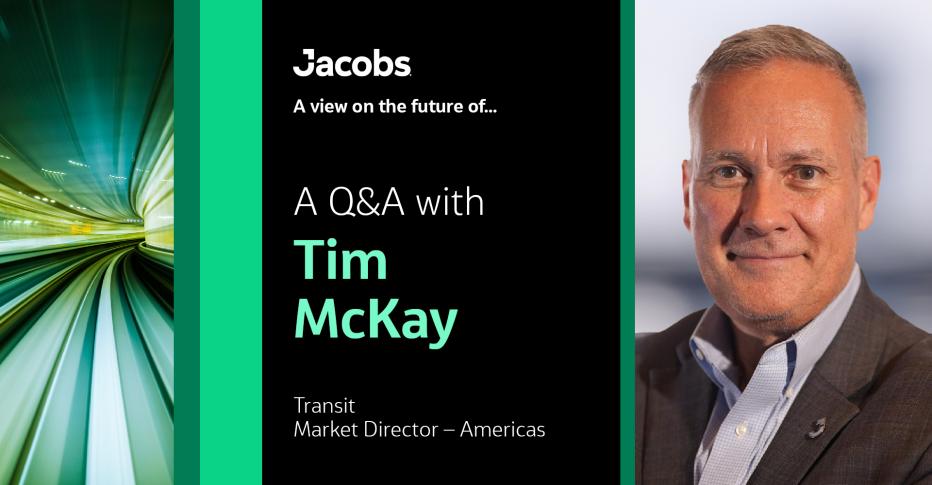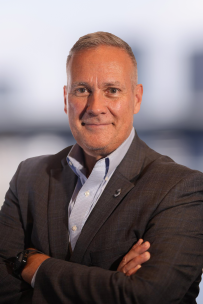
Public transportation systems, valued as some of the most equitable and sustainable modes of transportation, connect communities and help stimulate economic development.
Expanding these complex systems and adding more advanced solutions, such as high-speed rail and decarbonization, to meet public demand can be an intricate, high-intensity ride.
Whether the journey includes keeping pace with capacity building and accelerating technology innovations, ensuring safety and security or maintaining transport networks, Jacobs is on board to serve all aspects of high‐speed and conventional passenger rail, freight and logistics, mass/public transit and innovative bus solutions. We’re a globally recognized leader in the safe and efficient delivery of rail and transit solutions – from planning, design and development to delivery and management.
In this Q&A, we connect with one of our teammates, Tim McKay, our new Americas market director for transit, to talk about the trends and technologies on track to make an impact on rail & transit solutions of tomorrow.
Tell us a bit about what a day in the life is like as Americas Market Director for Transit, and what we offer to our clients in this area.
As the Americas Market Director for Transit, I will be the collective conduit of the power of Jacobs focused on providing transit solutions for the needs of our clients. The power of Jacobs lies within our people, our relationships built on trust and a foundational commitment to innovation.
At Jacobs, our more than 1,500 professionals serve all aspects of the rail & transit industry . From bus transit and commuter rail to people movers and mass transit, we keep people and goods boldly moving forward. We deliver cross-cutting solutions including consulting & advisory services, planning and environmental, program and construction management, systems and rolling stock, design services, and sustainability and resilience. Our global portfolio of projects has supported clients with addressing dynamic issues like aging infrastructure, security and safety risks, an evolving technological landscape, connectivity and accessibility.
What are the biggest transit challenges today?
One of the biggest transit challenges today is the issue of resources, which encompasses both funding and experienced personnel. This challenge is compounded by escalating costs and the complexity of managing large, high-profile critical projects. Additionally, project delivery often lacks a strong focus on the end user or operator, which can lead to inefficiencies and dissatisfaction. Looking ahead, future funding for critical transit programs and operations remains uncertain, and there’s a pressing need to attract young talent into the industry to ensure its sustainability and innovation.
How do we help clients think differently to solve those challenges?
To help clients think differently and solve transit challenges, we focus on growing capacity at local, regional, statewide, national and global levels through reciprocal partnerships. Additionally, we help our clients explore implementing collaborative delivery methods that can mitigate risks and provide greater certainty of on-time or early, and on-budget project completion, significantly reducing changes and claims. We also know that engaging stakeholders early in the process can lead to optimized project life cycle cost benefits, so we assist in keeping all interested parties connected throughout the process.
Members of our team also advocate at the governmental level to fund transportation priorities, moving these critical pieces of infrastructure forward and providing enhanced connection for the traveling public into the future.
It’s estimated that public transportation in the U.S. saves 37 million metric tons of carbon dioxide annually. Where do you see the industry heading when it comes to green fleets and other sustainable modes of transit?
Public transit plays a crucial role in the energy transition, with annual emission reductions equivalent to the combined electricity used by households in major cities like New York, Atlanta, Washington D.C., Denver and Los Angeles. The shift toward greener transportation is driven by three main pathways: decarbonization through sustainable design and construction, the adoption of electric vehicles and hydrogen propulsion, and the use of sustainable power sources such as wind, solar and batteries. Collaborating with our energy & power teams, we’re actively working to advance this transition and look forward to its continued progress.
What are the biggest opportunities ahead in transit?
The power of partnerships is pivotal in addressing critical transit challenges and unlocking new opportunities, particularly in decarbonization, resilience and the application of artificial intelligence (AI) and big data solutions. By collaborative with diverse stakeholders, we can drive innovation and implement sustainable practices more effectively. Partnerships enable the pooling of resources and expertise, which is essential for developing and deploying AI and big data technologies to optimize resource use, provide critical asset management and improvements, and predict industry trends.
An example is StreetLight Data, who Jacobs acquired in 2022. StreetLight applies proprietary processing technology to location data from millions of mobile devices, connected vehicles, IoT sensors and geospatial databases to measure multimodal travel patterns – and makes them available via its online SaaS (Software as a Service) solution StreetLight InSight®. In the transit space, we use StreetLight software not just for planning efforts, but now also during construction to coordinate street closures and haul routes.
Collaborations like these foster resilience by integrating advanced technologies and sustainable practices, ensuring that transit systems are robust and adaptable to future demands. Through strategic alliances, we can accelerate the transition to greener, more efficient transit solutions and redefine industry standards.
Is there a project you’re particularly proud of?
For me, every project is unique and holds the opportunity to make a difference, whether it involves growing local capacity through small businesses, providing the community with choices for better access to jobs, schools, or healthcare, increasing property values through transit-oriented development that builds wealth, enhancing local services that benefit nearby residents, or fostering the growth of our employees, stakeholders and partners. All these efforts translate to giving back to an incredible industry and make me incredibly proud.
About the interviewee

Recently named as Jacobs’ Transit Market Director in the Americas, Tim McKay brings extensive experience demonstrated over a 40-year career leading strategic planning, design, construction, communications, railroad management, real estate and development, quality, safety, interface management/system integration, alternative/collaborative project delivery, dispute resolution, negotiation strategies, project and program management teams on large scale transportation (rail, transit, aviation, roads and bridges, and water) projects. His proven leadership skills include advising, consulting, directing and implementing policies, programs and operating strategies related to transportation systems across the country. His achievements are grounded on the application of a personal philosophy of success through teamwork, collaboration and old-fashioned hard work, while fostering creativity in meeting the needs of a diverse populace.
Personally, Tim and his wife, Pam, have been married for 35 years, and they have one daughter, Gracen, who is a college sophomore training to become a nurse. Tim is an avid sportsman and holds a professional dive status of Dive Master and a non-professional status of Master Diver. He coached basketball in the city leagues and Upwards program for 30 years and wrestled a black bear as part of an exhibition during his freshman year in college, which parallels most large, complex, public projects in that you do not stop to rest when you are tired, you stop when the bear is tired.














































